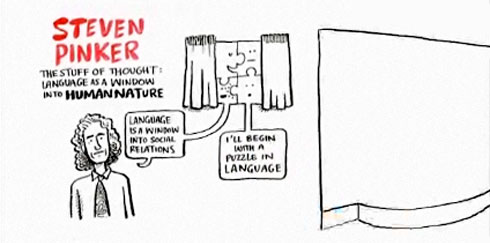Maillardet’s Automaton – A Real Life “Hugo”
January 13, 2012

If you’ve seen Hugo, the Martin Scorcese-directed adaptation of Brian Selznick’s marvelous children’s book The Invention of Hugo Cabret, you’re already familiar with the 18th century passion for automations: mechanical wonders that mimicked the behaviors of dancers, magicians, circus acrobats, fortune tellers and more. They were far more than children’s wind-up toys. These automatons were clockwork mechanisms made for royalty and the very rich that were capable of astonishing, if limited, performances.
The “Draughtsman-Writer” above was built by Henri Maillardet and is capable of reproducing four drawings (an example is below) and three poems. Click here to see videos of this amazing machine in action at the Franklin Institute.

Zombies: Infographic
January 12, 2012
In 2011, Mexico City held the world’s largest zombie walk with 9,860 registered marchers. The event was held, in part, to collect donations for a local food bank. This broke the previous record set in Asbury Park, NJ in 2010 where they gathered 4.093 zombies. I’ve written about Zombie Walks before. Now here’s an infographic about zombies and the walks held to celebrate them . . .click on image for larger size.
How Memory Works: Infographic
January 12, 2012
For many years I’ve been fascinated by workings (and failings) of human memory. If not for the continuous autobiographic stream of our memories, how would we know who we are? Can we always rely on our memories to be an accurate record of our past?
The best single volume reading on the topic has to be Daniel Schacter’s Searching for Memory: The Brain, the Mind, and the Past. I’d also highly recommend Eric R. Kandel’s book, In Search of Memory, which I’ve previously written about.
For a quick overview, here’s an excellent infographic from OnlineColleges.net on the subject. . .click on image for larger size.
Backwards Ran Sentences: The Best of Wolcott Gibbs from the New Yorker
December 29, 2011
As a lifelong obsessive, compulsive reader it always saddens me when I reach the end of a favorite author’s lifetime output.
It’s satisfying but somewhat melancholy to realize that I’ll never read another piece by – insert names here [Aldous Huxley, A.J. Liebling, Joseph Mitchell, Raymond Chandler, Dashiell Hammett, Dorothy Parker, etc.] for the first time.
How sweet it is, then, to newly discover another writer who may securely lodge in my personal pantheon. Just such a discovery happened late this Fall when I came across a compilation of work by Wolcott Gibbs; six hundred and fifty-three pages of precisely rendered prose from a sensibility as jaundiced as my own.
I offer the short excerpt below as a sample.
__________________________________________________________________________________
Day after day Laura Jean Schanze, a rather sinister little girl in the Clinton, New Jersey public school sat at her desk writing down the mistakes her teacher, a Miss Melick, made in English. Miss Melick said “poopils” when she meant “pupils” and “arn” when she meant “iron;” once in an unexplained crisis she exclaimed, “There ain’t no Chinamens in here!”
In the end Laura Jean’s dark industry was rewarded and Miss Melick was dismissed by the school board. This episode illustrates a quality we have always felt in little girls – something derisive, watchful and colder than the climate on the moon. For some reason it reminds us of a conversation we overheard on the beach the other day. Two young ladies, each perhaps fifteen, lay on the sand and talked of love.
“So,” said one of them, “he told me he was giving up smoking for me. For me, for God’s sake! He thinks I’m worried because he’s stunting his nasty little growth or something.”
“They all do,” said the other, and the baby gorgons laughed together, a silvery music, ancient and terrible.
Talk of the Town, August 27, 1938
from Backwards Ran Sentences: The Best of Wolcott Gibbs from the New Yorker
___________________________________________________________________________________
“Zone One” by Colson Whitehead, A Zombie Novel You Can Read in Public Without Embarrassment
December 7, 2011
“So tentative bureaucracy rose from the amino-acid pools of madness, per its custom.”
– from Zone One by Colson Whitehead
Anyone who knows me well, knows how much I like zombies, as a horror genre. (If they were real, I’d probably turn against them, for purely practical reasons). There are a lot of very low-budget zombie films that are pretty much unwatchable and indefensible, but the genre does contain a few classics and some great, entertaining if decidedly “B” caliber movies.
Why, for example, critics routinely bash the Resident Evil films I will never understand. They deliver exactly what they promise. I do have to admit to great bias here, however. I would watch a movie of Mila Jovovich breathing.
In literature, the pickings are far slimmer. I found a well-regarded short story compilation, Book of the Dead, edited by John Skipp and Craig Spector to be mostly forgettable with the exception of 2 or 3 entries. There were also a couple where gratuitous sex ruined the narrative for me. The implausible double-penetration of a waitress via a zombie father and son in one story made me wonder if the author was 14 years old and had never seen a real lady naked. I mean, Zombie sex? Really?
The Walking Dead: Rise of the Governor by Robert Kirkman and Jay Bonansinga is part of the Walking Dead TV show and comic book franchise. I was an early fan of the comic book and think the AMC show is an excellent adaptation. The book, however, is for completists only. It adds almost nothing to the experience of the comic or the TV series.
And, although it is completely authorized and co-authored by Walking Dead creator Kirkman, there are continuity errors between the book and the comic (the sign outside Wiltshire Estates was one that stuck out for me). Where have all the proofreaders gone, I wonder?
If you want to experience your zombies on the printed page I would recommend Otto Penzler’s Zombies! Zombies! Zombies! a massive 832 page anthology that includes the best stories from Book of the Dead as well as the first reportage in English about Haitian zombies, W.B. Seabrook’s “Dead Men Working in the Cane Fields.”
In the category of novels, there are only two that I think are worth your time: Tony Burgess’ Pontypool Changes Everything from 1998 and 2011’s Zone One by Colson Whitehead.
Zone One has gotten phenomenal reviews from publications that matter like The New York Times Book Review, Los Angeles Times, Entertainment Weekly, GQ, USA Today, Esquire, New York Observer, The Washington Post, Houston Chronicle, Publishers Weekly and more.
However, genre fans are dissing it long and loud on Amazon.com. Not enough red meat for them, I imagine. This is the crowd that Skipp and Spector’s Day of the Dead was compiled for. I disagree with almost every criticism they throw at Zone One.
Whitehead is a well-regarded mainstream novelist and a MacArthur Grant recipient, dipping into the zombie genre for the first time. This fact alone seems to outrage the double-digit IQ crew. There are similar criticisms in the letter pages of The Walking Dead comic whenever the focus stays too long on the living, trying to cope with the post Zombie Apocalypse world.
This is the difference between reading (and thinking) and contemporary porn. In the 1970s era of porno chic, X-rated films had actual plots and attempts at characters, albeit with regular as clockwork hardcore sex scenes. Now porn has gone ‘gonzo’ and it’s all one semi-pneumatic scene after another. The critics of Zone One seem to desire a zombie novel that is simply one gore fest after another. Just give me the ‘good parts’, they demand, and don’t make me think. Just like porn.
Personally, I loved Whitehead’s prose style and the pacing and originality of his storyline. It’s also filled with wonderful lines like the one quoted above. Zone One wasn’t written for the fanboys. Ignore the critics on Amazon. It’s a literary zombie novel for adults with a brain. A big, fat juicy bra-a-a-a-a-in!
George Plimpton’s Video Falconry and John Hodgman
November 17, 2011
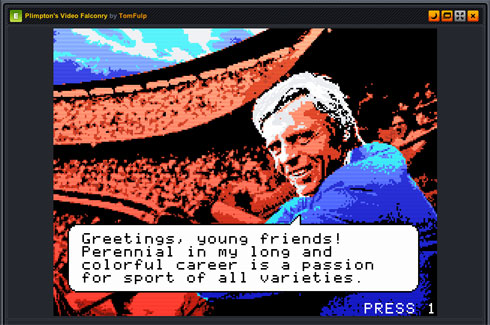
Screenshot of an opening scene in George Plimpton’s Video Falconry.
I’m pretty much eliminating all those people in my life who don’t share my worship of John Hodgman. If you’re asking yourself, who is John Hodgman? There may still be hope for you.
John Hodgman is a minor television personality and author. He was the PC in the “I’m a PC” – “I’m a Mac” commercials for Apple. (Justin Long was the always-triumphant Mac). He makes monthly appearances on The Daily Show with Jon Stewart and shows up a lot on the Rachel Maddow Show. He has a podcast, Judge John Hodgman where he delivers rulings on problems brought before by ordinary, non-famous people. It is hysterically funny.

But I encountered him first as the author of The Areas of My Expertise (2006), a compendium of fake complete world knowledge. This work spawned a sequel, More Information Than You Require (2009) and now, the final book in the continuously paginated trilogy, That Is All (2011).
Here are two opinions on the new book taken from the listing on Amazon’s site:
“Sit in public laugh out loud smile to yourself funny literature.”
“I liked his appearances on the Jon Stewart show, but this book is not one bit funny or interesting. Thanks goodness I ‘acquired’ it at a local library and didn’t buy it.”
Now who can take the opinion of a person who steals books from a local library seriously? Need it be said that I agree with the ‘laugh out loud funny’ review? I didn’t think so.
Anyway, mention was made in the Judge John Hodgman program and the book That Is All of an obscure 1983 ColecoVision videogame, George Plimpton’s Video Falconry.
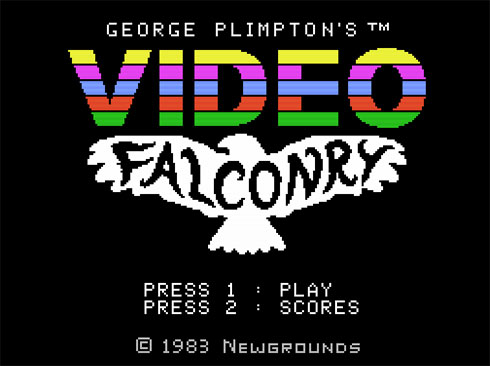
Intrigued, game programmer Tom Fulp took up the challenge to first, locate a game cartridge – it cost $500 – then spend the 31 days necessary to port the game to play in the web browser of your choice. Go here to do that. It’s free and actually fun to play. Claw grab. Beak grab. Claw grab. Claw grab. Claw grab.
It also has one of those monophonic looped 8-bit electronic scores.
If you lived through that era nothing brings you back more vividly than those maddeningly elliptical soundtracks. You can also watch a video and learn the whole twisted story, from George to John to Tom and how a 28 year old video game is resurrected.
In turns out that George Plimpton’s Video Falconry was especially obscure because most of the product wound up being junked due to conflicting endorsement deals Plimpton had made. Only a few cases of the games actually made it onto store shelves.
And that is more information than you require about George Plimpton’s Video Falconry.
The takeaway: these are serious and difficult times and the country cries out to its scores of deranged millionaires, make sense of it all for us. Or if not that, entertain us. John Hodgman is one of the few deranged millionaires to actually take up this challenge. If you have any discretionary income at all, get the economy moving again and buy one of his books.
Zombies Worth Over $5 Billion to US Economy
October 31, 2011
24/7WallStreet.com analyzes the economic boon of the walking dead in all media, and comes up with a $5 billion figure.The impressive figures author Jon C. Ogg comes up with are below. And he even thinks these are all low-ball figures!
Regardless of the reason, zombies are worth billions of dollars. The figure that we were able to piece together: $5.74 billion. In all honesty, this tab is grossly undercalculated in each category. By the time you add the money spent in total around the zombie genre, the figure is much higher.
For the detailed analysis of how he derived these numbers, read the complete article here.
Movies > Zombie economy: $2.5 billion
Video games > Zombie economy: $2.5 billion
Comic books, magazines and TV > Zombie economy: $50 million
Halloween costumes > Zombie economy: $500 million (over a 4-year period)
Books and novels > Zombie economy: $100 million
Conventions, events and walks > Zombie economy: $10 million
Merchandise > Zombie economy: $50 million
The digital world > Zombie economy: $10 million
Music > Zombie economy: $10 million
Go here for the Top Ten Zombie Music Videos
Art > Zombie economy: $10 million
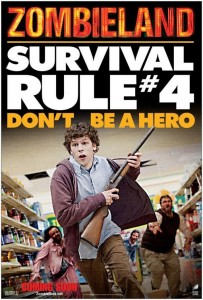

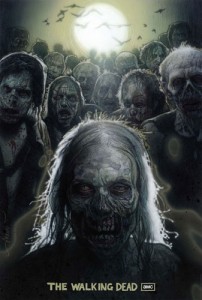
New “Dragon Tattoo” Trailer with dialogue
September 23, 2011
Mikael Blomkvist: “What are you doing?”
Lisbeth Salandar: “Reading your notes.”
Blomkvist: “They’re encrypted.”
Salandar: “Please.”
Steven Pinker: Language as a Window into Human Nature
August 24, 2011
In this animation, Steven Pinker, experimental psychologist, cognitive scientist, linguist and author of The Blank Slate: The Modern Denial of Human Nature, How the Mind Works, The Stuff of Thought: Language as a Window into Human Nature and more, shows us how the mind turns the finite building blocks of language into infinite combinations.
If this short intrigues you, I highly recommend the three books listed above. Fascinating, thought provoking material, exceptionally well-presented for the lay reader. Along with Richard Dawkins and Christopher Hitchens, Mr. Pinker is one of my dream lunch dates. . .
There are No ‘Colors’ There is Only Light
August 24, 2011

The grey tiles on the left look blue and the grey tiles on the right look yellow. But they are grey in each image.
Beau Lotto is appearing on the BBC’s Horizon show with a program called Do You See What I See? about color perception where he explains that color (or colour) is not in the objects we perceive, but rather manufactured in our brains. The conclusion he draws from this is, I think, wonderful.
So we all see the world differently. Indeed, we have no choice about this because our experiences of the world are necessarily different. None of us sees the world as it is. In this sense we are all delusional, what each of us sees is a meaning derived from our shared and individual histories. This awareness, possibly more than anything else, provides an irrefutable argument for celebrating diversity, rather than fear in conformity. Which is liberating, since knowing this gives you the freedom (and responsibility) to take ownership of your future perceptions of yourself and others.



